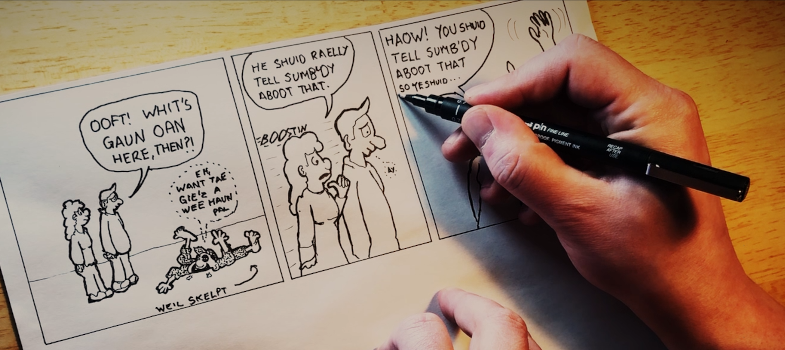Lesson Title: "Yir Ain Voice" – Writing in Scots
Class Level: Primary 7
Lesson Duration: 2 sessions (can be extended if needed)
Learning Intentions:
-
I am learning to write in Scots using the words and spellings that reflect my own voice and dialect.
-
I am learning to notice patterns in Scots spelling and how they link to pronunciation.
-
I am learning to share ideas through writing that sounds natural and expressive.
Success Criteria:
-
I can use Scots words in my writing and explain their meanings.
-
I can spell Scots words using what I know about how they sound.
-
I can write a short script, comic, or diary entry in Scots that feels true to how someone would speak.
Lesson Overview:
This lesson will introduce learners to the idea of Scots spelling being based on how words sound. Pupils will explore unique Scots words, as well as those that are similar to English but spelled and pronounced differently. They’ll use these to create a short, voice-led writing piece that feels personal and natural — like a diary entry, comic strip dialogue, or spoken-style monologue.
Lesson Activities:
Session 1: Exploring Scots Vocabulary and Spelling
-
Warm-up Word Bank Game (10 min):
Pupils brainstorm Scots words they know (e.g. dreich, bahookie, wee, aye, glaikit, fankle). Add new ones using the Scots Dictionary for Schools app or DSL online.
-
Group Sorting Challenge (10 min):
Sort words into three categories:
-
Unique to Scots (e.g. burn, loch, blether)
-
Similar to English, different spelling (e.g. heid, scoor, soond)
-
Same as English (e.g. there, and)
Discuss how spelling links to how we say them.
-
Mini Translation Task (15 min):
Pupils rewrite a few simple English sentences in Scots (e.g. “I was late because I lost ma bag in the cludgie.”). Focus on using sound-based spelling.
-
Introduce Main Writing Task (10 min):
Pupils will choose between:
-
Writing a diary entry from the point of view of someone living in Scotland in the past or present
-
Creating a Scots comic strip (drawing + speech bubbles)
-
Writing a short scene with two pals bletherin
Pupils plan their idea using a planning sheet: Who’s speaking? What happens? What Scots words will they use?
Session 2: Writing and Reflecting
-
Writing Time (30–40 min):
Pupils draft their piece, using Scots spellings they’ve learned and practiced. Teacher circulates and supports where needed.
-
Peer Share or Author’s Note (10–15 min):
Pupils either:
-
Optional Extension / Display Task:
Create a class display titled "Sayin It Yir Ain Way" featuring snippets from everyone’s work and a word wall of favourite Scots words.
Resources:
-
Scots Dictionary for Schools app / DSL website
-
Sample Scots texts or comic strip templates
-
Planning sheet (who’s talking, what’s happening, key Scots words)
-
Example sentence cards for translation starter
-
Videos (optional): Michael Dempster – Dignity or Origins of Scots
CfE Literacy & English Experiences and Outcomes:
-
LIT 2-13a / LIT 2-14a / ENG 2-17a – Understanding and using Scots in reading and writing
-
ENG 2-27a / 2-31a – Creating expressive texts in Scots
-
LIT 2-10a / 2-09a – Talking about language, pronunciation, and how words are spelled
Delivering this Scots lesson to my Primary 7 class was a rewarding experience that brought language, identity and creativity together in a meaningful way. One of the biggest successes was how naturally the pupils engaged with the concept of writing in their own voice. Many of them felt empowered by the idea that their local language – something they often use at home but rarely see in writing – had value in the classroom. Using a flexible structure (comic strip, diary, or dialogue) helped everyone find an entry point that suited their confidence and interests. It also reduced the pressure of ‘getting it right,’ especially when it came to spelling Scots words, and opened the door to some brilliant pupil-led discussions about pronunciation and dialect.
A particular strength of the lesson was encouraging a phonetic approach to spelling. Pupils began recognising patterns like oo in Scots (e.g. soond) and enjoyed finding ways to spell words based on how they say them. However, some did fall into writing in English and ‘adding in’ Scots words. With more time, I would build in more spoken Scots modelling and shared reading in Scots to immerse them further before they write.
Going forward, I plan to reinforce this learning by integrating Scots into regular classroom routines – through brain breaks, reading aloud, and vocabulary tasks. A few pupils have even asked if they can write their next story in Scots, which speaks volumes about the impact this has had on their confidence. Next time, I’d like to link their Scots writing to a topic like local history or storytelling, deepening the cultural connection and making room for cross-curricular links.
